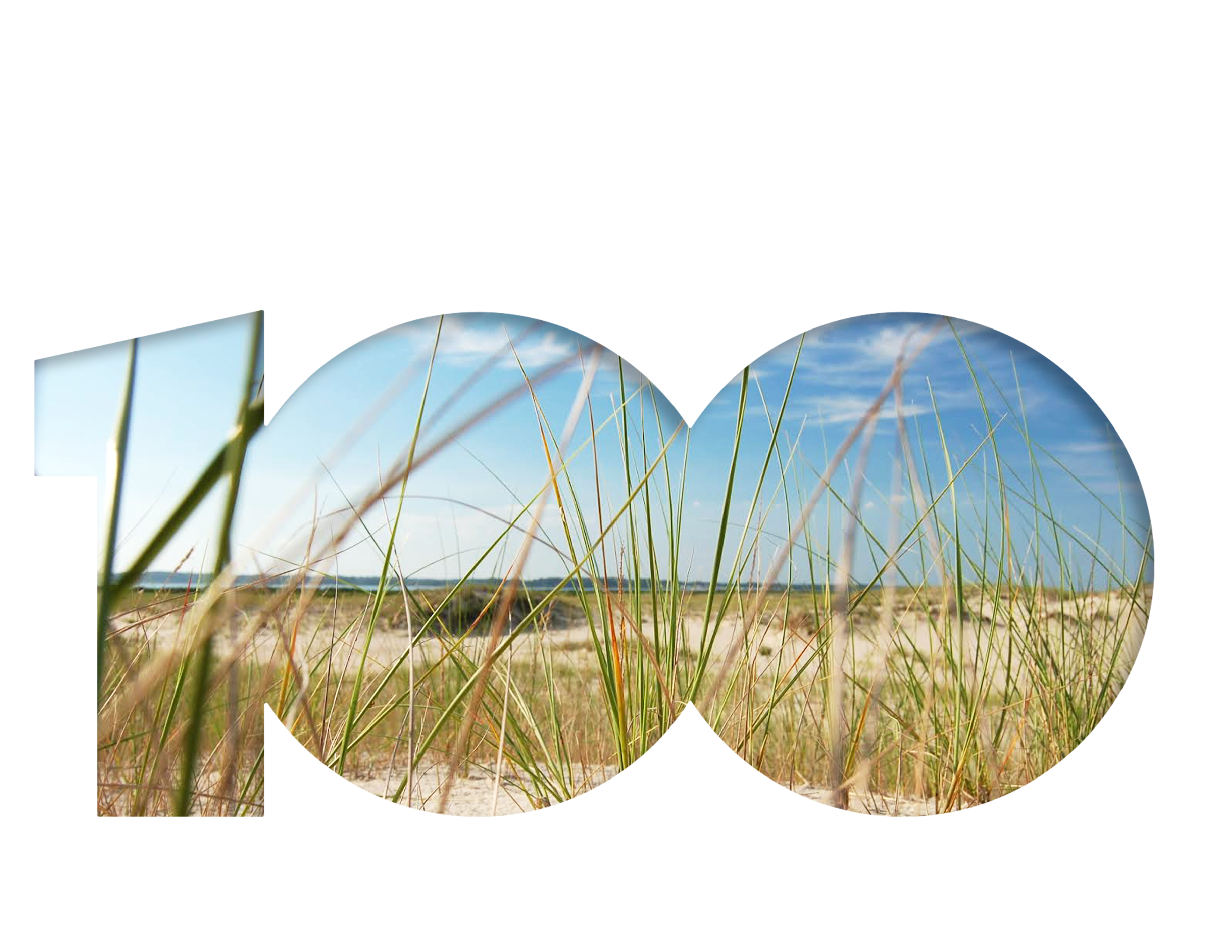Seas on the Rise: Extreme Flooding Impacts
Alison Novara ·Hurricane Helene is a storm that will go down in history books. The devastation Helene brought to the people of the Florida Big Bend region was extensive, and was shortly followed by another major hurricane, Hurricane Milton. Helene’s peak storm surge in Cedar Key, Florida, was measured as 10.33 feet, surpassing all known records of storm surge for the Big Bend area1. Why do coastal flooding and storm surge events seem to be getting worse and worse? Is there anything better we can do to prepare for these major storms?
What is sea level rise?
Climate change impacts are more prevalent than ever, with one major indicator being sea level rise. Driven by the increase in Earth’s average temperatures, sea surface temperatures rise as well. As water absorbs heat, or gets warmer, water expands. With nowhere to go but up, sea levels rise, significantly affecting our coastal regions. Not only this, but as glaciers at higher latitudes melt, the volume of water in the ocean also increases, further raising sea levels2. The Sea-Level Rise Expert Group details in their 2023 Projections Report that the sea level at Maryland shores’ specifically could rise by a foot and a half between 2000-20505.
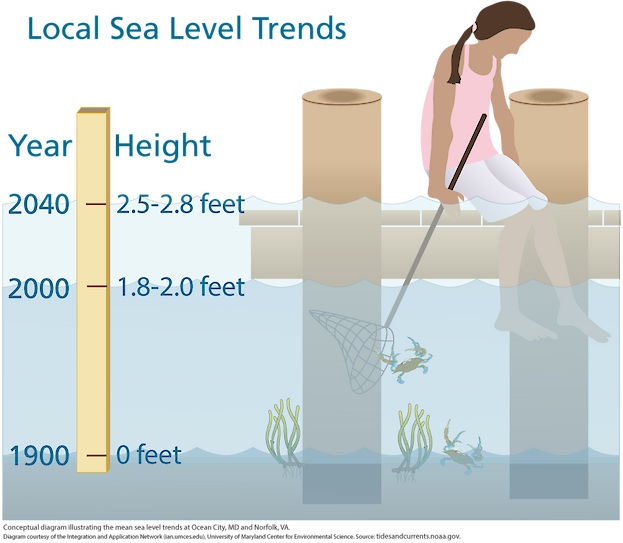
Why are coastal flooding and storm surge events more frequent?
Another indicator of climate change is coastal flooding. Coastal flooding is becoming more common due to frequent, intense storms (another climate change indicator!), as well as sea level rise. Storms bring heavy rainfall and storm surge, increasing coastal flooding. Rising sea levels decrease the disparity between average sea level and land elevation, so progressively more coastal communities are experiencing an increase in flooding on normal days, defined as calm and sunny days. Now, even normal tidal events can cause an inundation of water in areas where it might not normally be, increasing the frequency of coastal flooding events2.
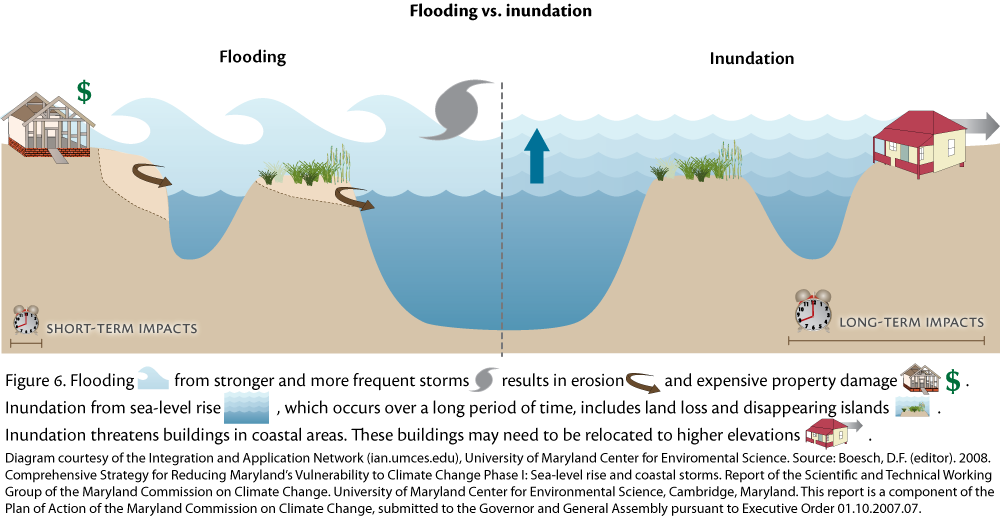
As these events become more frequent, how does it impact us?
Impacts of coastal flooding are compounding. When an area first experiences coastal flooding, minor repercussions such as storm drains becoming obsolete, school delays, and road closures arise3. Over time, regular flooding events induce deterioration of infrastructure, as they may not be able to withstand saltwater deluge or strong storms, leading to collapse. Failure of wastewater treatment facilities exposes local communities to pathogens and harmful chemicals 2,3. Saltwater intrusion into freshwater aquifers contaminates these stores for the community2. Damage to healthcare facilities reduces the ability of these systems to respond in times of crisis4. Not only this, but there is usually a lack of electricity and clean water after storm events6. These all pose serious threats for the 40% of Americans living along our coasts2,3.
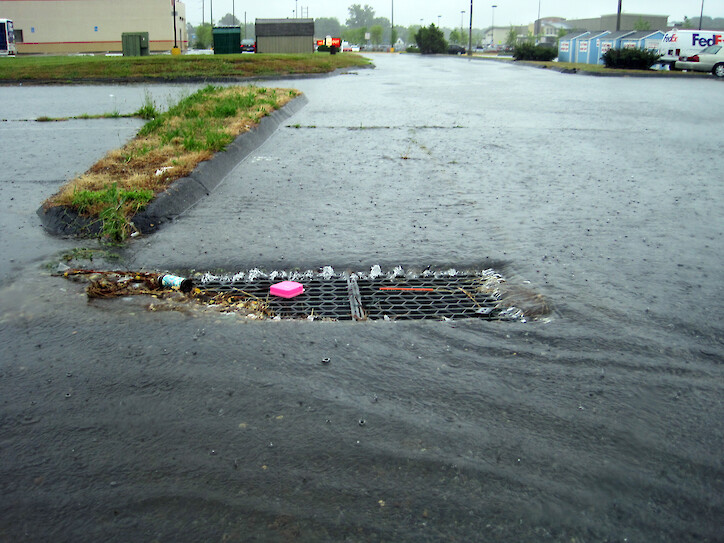
How do flooding hazards affect the coastal environment?
Sea level rise and coastal flooding cause severe wetland habitat loss, particularly of salt marshes and mangroves6. These habitats are vital for coastal wildlife communities, as well as humans. Saltwater intrusion and landscape alteration of these environments displace animal populations2. Important fishery species rely on these habitats for nursing areas, and they also provide us with waste assimilation and flood protection services6. Oil spills and fires characteristic of the aftermath of intense storms and flood events exacerbate coastal pollution5.
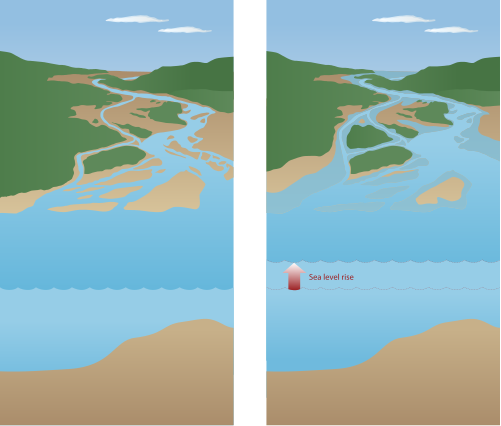
Underserved coastal communities’ struggle with increased flooding hazards
On October 16th, 2024, Dr. Natalie Snider, Science Integrator at the Integration and Application Network, discussed in our Coastal Environment and Community Health class the disproportionate impacts flooding hazards have on the livelihoods of low-income and minority populations. These communities struggle to bounce back following a storm or flooding event. Economic drivers of a community, like ports, fisheries, tourism industries, and other businesses, are disrupted by these events. Hourly employees cannot get to work, or their work is closed, halting their cash flow. With no income, rebuilding becomes a nightmare. Decreased property values, limited access to affordable housing and insurance for those that are displaced further hinder their recovery, leaving residents susceptible to predatory processes and lenders. Other essential services, such as education systems, childcare, and healthcare, are shut down in the wake of floods and storms5.

Louisiana’s solution, and why it works
Dr. Snider, who has worked extensively on coastal and flood resilience along the East and Gulf coasts, highlighted Louisiana’s response to Hurricane Katrina. In the wake of Katrina’s destruction, Louisiana began several initiatives to better prepare and help those in need after community devastation, such as the LA Safe Program. A mixture of best planning practices and expertise, community and stakeholder vision, and current and future environmental impacts, LA Safe focuses on the people impacted, and partners with the Foundation of LA. Their “high-level policies” include managing flooding and subsidence, planning for safe and affordable development, improving mobility through the region, diversifying educational and employment opportunities to strengthen the regional economy, and supporting healthy communities, regional culture, and recreational access to nature. The community themselves got to vote on which projects would be funded, ensuring tailored support for their specific needs5.
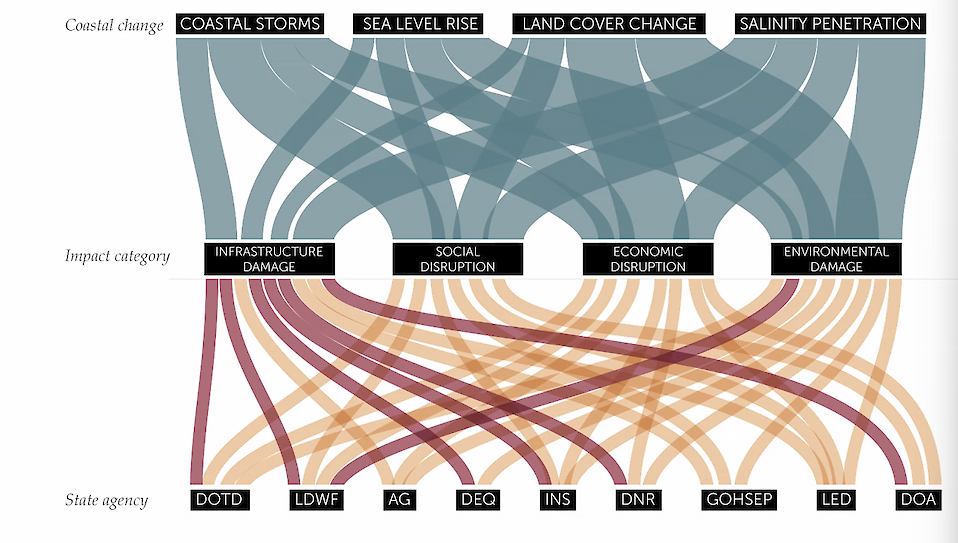
Community Solutions
Community member-based programs, such as LA Safe, seem to provide the best protection for peoples’, homes’, and businesses’ livelihoods against extreme flooding events7. Strategic, sustainable initiatives such as reducing impervious surfaces immediately inland from shorelines, increasing stormwater volume controls, and implementing living shorelines all help to conserve the natural environment, while also helping the local community. Reducing impervious surfaces, or surfaces that water cannot penetrate such as concrete, can reduce the amount of runoff and lessen flood water. Living shorelines, consisting of native plants, restore natural habitats and naturally mitigate flood events by providing shoreline protection7. Increasing resiliency funding and flood preparedness through multi-agency planning will ensure long-term change is established and provides a more holistic view of what the community really needs to bounce back quickly after extreme flooding events4,7.

The integration of a living shoreline and reducing impervious surfaces close to the shore allows better filtration of runoff, traps sediment, and conserves natural habitats for wildlife. Source: “Shoreline Erosion” by Jane Hawkey from Integration and Application Network is licensed under CC BY-SA 4.0.
References
1Hurricane Helene Recap: Catastrophic Surge, Inland Flooding | Weather.com. (n.d.). The Weather Channel. Retrieved October 17, 2024, from https://weather.com/safety/hurricane/news/2024-09-27-hurricane-helene-recap-surge-rainfall-flood-florida-southeast
4Landeg, O., Whitman, G., Walker-Springett, K., Butler, C., Bone, A., & Kovats, S. (2019). Coastal flooding and frontline health care services: Challenges for flood risk resilience in the English health care system. Journal of Health Services Research & Policy, 24(4), 219. https://doi.org/10.1177/1355819619840672
7Major Flooding Across Chesapeake Bay Watershed Highlights Need for Lasting Solutions From MD and VA Legislators. (n.d.). Retrieved October 17, 2024, from https://www.cbf.org/news-media/newsroom/2024/all/major-flooding-across-chesapeake-watershed-highlights-need-for-lasting-solutions-from-md-va-legislators.html
6Nicholls, R. J. (2004). Coastal flooding and wetland loss in the 21st century: Changes under the SRES climate and socio-economic scenarios. Global Environmental Change, 14(1), 69–86. https://doi.org/10.1016/j.gloenvcha.2003.10.007
5Snider, Natalie. (2024, October 16). Coastal & Flood Resilience Issues. Integration and Application Network.
3US EPA, O. (2016, July 1). Climate Change Indicators: Coastal Flooding [Reports and Assessments]. https://www.epa.gov/climate-indicators/climate-change-indicators-coastal-flooding
2US EPA, O. (2016, June 27). Climate Change Indicators: Sea Level [Reports and
Assessments].
https://www.epa.gov/climate-indicators/climate-change-indicators-sea-level
About the author
Alison Novara

Alison Novara is a first-year PhD student at UMES in the Coastal Environmental Science Lab. She is interested in coastal ecology, specifically examining the impacts of climate change on our living coastal resources and applying this knowledge to influence policy. She currently researches climate impacts on bay scallops and other important shellfishery species. In her free time she likes to play tennis, go to the beach, and cook.
Next Post > Plastic pollution: A menace?
Comments
-
Jun Suk Byun 1 year ago
Nice blog Alison! I had almost zero knowledge about flooding, inundation, and their impact on coastal communities. The layout and visualizations were immensely helpful in grasping this concept. I like how you provided several examples where communities put together means to protect themselves from natural coastal disasters. Very informative!
-
Adetutu Adebayo 1 year ago
Thank you, Alison, for the amazing write up. We must stop activities that causes climate change and sea-level rise. We need a better climate for a saner world!
-
Ian Kalama 1 year ago
Love the blog! Especially the aspect of how communities struggle with floods and solutions and what works. Overall, very well thought out and informative.
-
Ani 1 year ago
Alison, love the structure of this blog (good balance of human and environmental impacts)! Very informative and paints a holistic picture of flooding impacts and the varied causes that influence communities. Concluding with potential solutions is a positive, hopeful, and helpful note to end on.
-
Loni Matthew 1 year ago
Great blog post! This was very informative and gives a clearer perspective on how the effects of sea-level rise impact the affected communities. Do the communities prioritize solving the damage from sea-level rise, or do they foresee moving further inland to be better protected in the future?
-
Taylor Breton 1 year ago
Great Blog Alison! I really liked how you tied in the topic to the recent hurricanes.
-
Ronita 1 year ago
Alison your blog effectively highlights the escalating impacts of sea level rise and coastal flooding due to climate change, emphasizing the need for community-driven, sustainable solutions like Louisiana's LA Safe program to enhance resilience and protect vulnerable populations.

